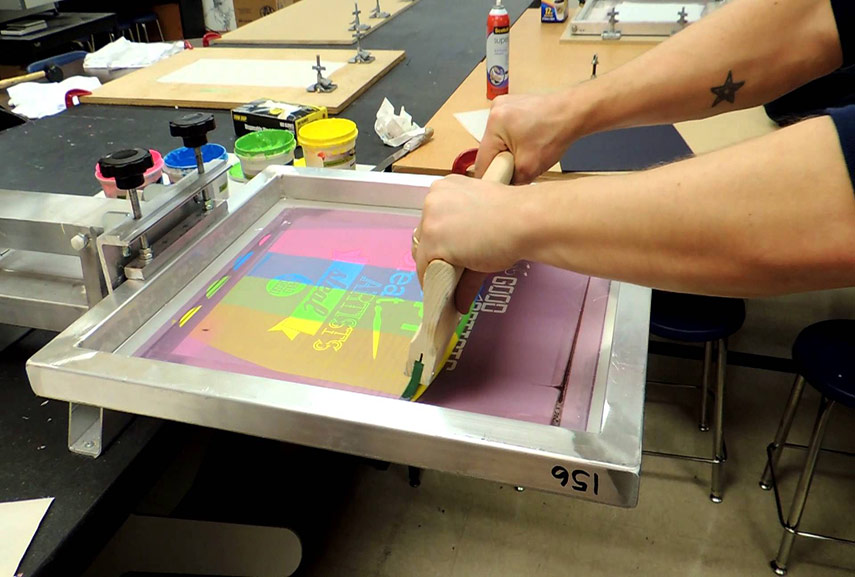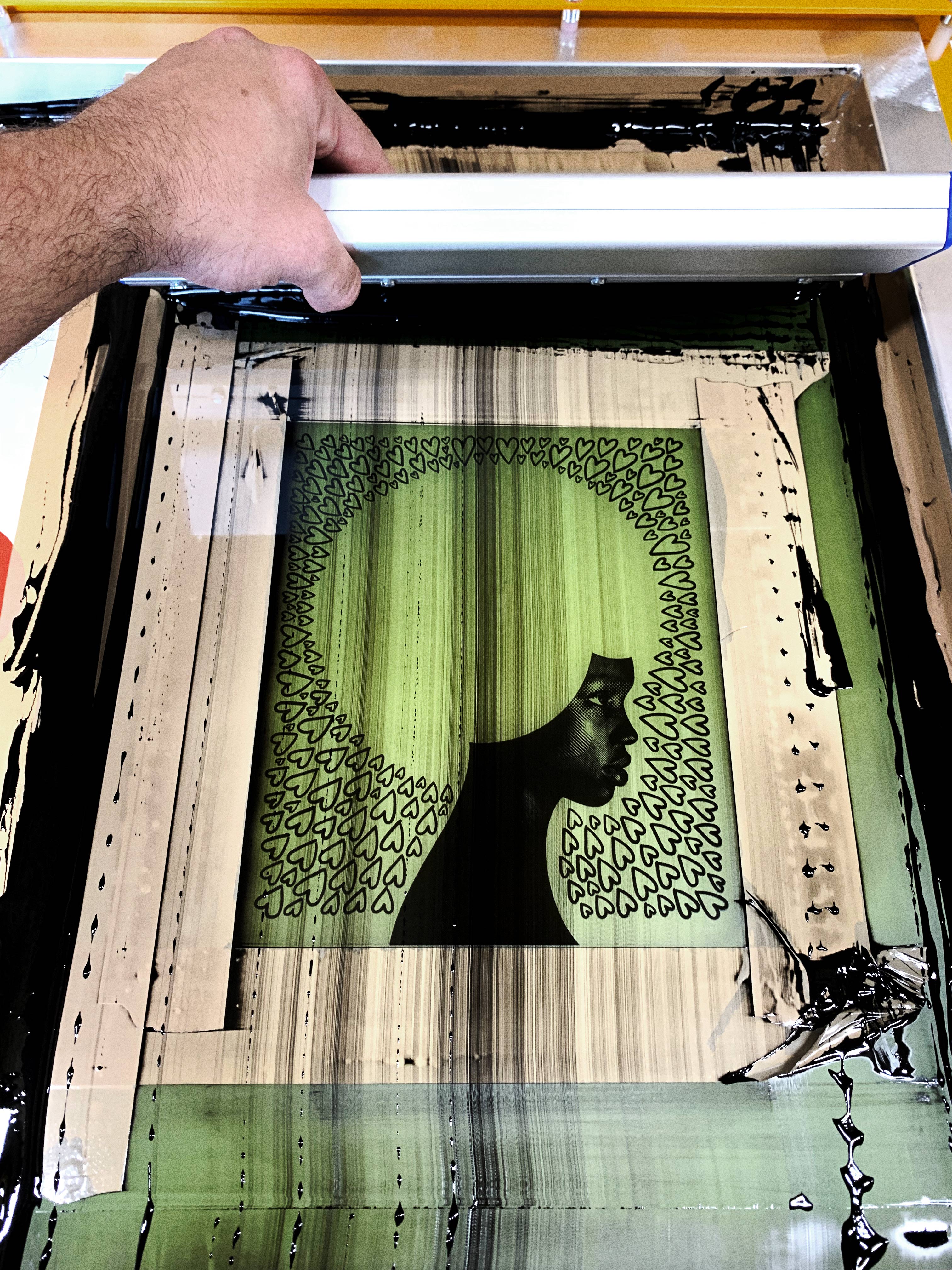ChatGPT said: How 10:9 Design Abilene is serving the community
Wiki Article
Discover the Numerous Sorts Of Screen Printing Techniques for Your Next Project
Screen printing offers a varied variety of methods that can enhance any kind of imaginative job. From standard approaches like serigraphy to modern-day advancements such as direct-to-garment printing, each technique has its distinct advantages. Specialized alternatives, consisting of metallic and environment-friendly inks, present much more possibilities. Understanding these strategies can significantly influence the last outcome. The challenge exists in picking the most ideal technique for details needs and desired results. What aspects should one think about?
The Basics of Screen Printing
Screen printing might appear complex, it is fundamentally a simple process that includes moving ink via a mesh screen onto numerous surface areas. The strategy starts with the creation of a stencil, which specifies the layout to be printed. This stencil is connected to a mesh screen, generally made from polyester or nylon. As soon as the pattern remains in area, ink is related to the screen and pushed through the mesh utilizing a squeegee, leading to the desired pattern being printed on the underlying material.Screen printing can be carried out on a wide variety of substratums, consisting of plastic, paper, and material, making it a versatile selection for various tasks. The procedure allows for elaborate styles and vivid shades, making it prominent in sectors such as advertising and marketing, art, and fashion. Recognizing these basics gears up people with the foundational knowledge needed to discover even more sophisticated strategies in screen printing.
Typical Screen Printing Techniques
Typical screen printing techniques have actually been employed for centuries, maintaining the craftsmanship and virtuosity of this approach. This method utilizes a mesh screen to move ink onto a substrate, such as fabric or paper, permitting for dynamic and resilient layouts. The procedure starts with creating a pattern, which obstructs certain areas of the screen to manage where the ink will certainly be used.One prominent method is serigraphy, usually used for creative prints and restricted editions. Another is the usage of water-based inks, which are environment-friendly and give a soft feel on fabrics - 10:9 Design near me. In addition, standard approaches can include hands-on printing, where artisans apply ink with a squeegee, making certain accuracy and focus to information
These strategies remain valued in the sector for their tactile top quality and the unique structures they produce, appealing to both creators and customers that value the heritage of screen printing.
Digital Screen Printing Innovations
As the need for faster manufacturing and personalization in the printing sector has risen, electronic screen printing developments have actually become a game-changer. This technology blends traditional screen printing approaches with electronic procedures, allowing for quick prototyping and detailed designs that were previously tough to attain. One substantial development is the introduction of direct-to-garment (DTG) printing, which facilitates top quality, full-color prints on various fabrics without the demand for displays. In addition, innovations in ink formulations have led to environmentally friendly options that keep vivid shades while reducing environmental influence. Using automated systems additionally enhances manufacturing, lowering labor costs and boosting precision. These innovations not only accommodate small batch orders and personalized designs however likewise enable quicker turn-around times, making them perfect for businesses concentrated on conference client needs in a hectic market. Digital screen printing, consequently, stands for a necessary advancement in the domain name of printing techniques.Specialized Screen Printing Methods
Exploring specialty screen printing approaches exposes a varied range of techniques that press the borders of creativity and capability in the printing industry. Among these, glow-in-the-dark inks supply a distinct aesthetic effect, making designs come active in low-light problems. Metallic inks, known for their glittering surface, include a touch of luxury to published products. One more cutting-edge method is discharge printing, which eliminates color from the fabric as opposed to including ink, resulting in a soft, classic feeling. High-density printing creates an elevated appearance externally, improving responsive interaction. Additionally, water-based inks are getting popularity for their vibrant colors and minimized ecological impact. Each of these specialty methods accommodates particular design requirements, enabling musicians and brand names to develop standout products that reverberate with their audiences. By leveraging these techniques, organizations can boost their screen printing tasks to brand-new heights, ensuring memorable perceptions.Eco-Friendly Screen Printing Options
Environmentally friendly screen printing options are obtaining traction as the sector moves in the direction of sustainability. Lasting ink choices and using biodegradable products are crucial elements in reducing the ecological influence of the printing process. By embracing these methods, screen printers can add to a more sustainable future while maintaining high-quality results.Lasting Ink Options

Biodegradable Materials Usage
As the screen printing sector advances, the consolidation of eco-friendly materials is coming to be progressively crucial for ecologically mindful practices. Designers and suppliers are now discovering inks and substrates made from natural, renewable energies that break down much more effectively than traditional equivalents. These eco-friendly options decrease plastic waste and reduce environmental influence, aligning with the expanding need for sustainable products.
Typical instances consist of water-based inks and organic cotton materials, both of which minimize dangerous chemicals and advertise eco-friendliness. Brands that embrace these materials frequently improve their market charm, attracting consumers that prioritize sustainability. As awareness of environmental concerns remains to increase, the shift towards biodegradable products in screen printing is likely to gain energy, promoting a greener industry standard.
Choosing the Right Strategy for Your Task
How can one figure out the most appropriate screen printing method for a specific task? The decision depends upon a number of aspects, consisting of the material to be printed on, the complexity of the style, and the preferred manufacturing quantity - 10:9 Design near me. For circumstances, direct-to-garment printing is ideal for detailed designs with numerous shades, while standard screen printing stands out for larger runs of easier graphics
In addition, factor to consider of the end-use of the published item is crucial. For outdoor applications, methods that offer sturdiness and weather resistance, such as plastisol ink, may be preferred. Alternatively, environmentally-conscious tasks may profit from water-based inks or naturally degradable products.
Ultimately, understanding the task's special needs allows for an enlightened option, guaranteeing both aesthetic charm and practical durability. By reviewing style complexity, product compatibility, and manufacturing scale, one can effectively pick the most suitable screen printing strategy to meet their project's objectives.
Often Asked Concerns
What Is the History of Screen Printing?
Screen printing came from in old China around 1000 AD, evolving via Japan and Europe. By the 20th century, it came to be prominent in business art and fashion, reinventing exactly how styles were generated and distributed around the world.
Just how Do I Prepare Art Work for Screen Printing?
To prepare art work for screen printing, one must ensure high resolution, make use of a suitable color mode, produce separate layers for each and every color, and convert text to describes, ensuring compatibility with the printing process and desired end result.What Materials Are Finest for Screen Printing?
The very best materials for screen get more info printing include top quality inks, resilient displays, and ideal substratums like cotton, polyester, or blends. Additionally, utilizing appropriate emulsion and squeegees can improve the printing process and results.Can I Evaluate Print in your home?
Yes, screen printing at home is feasible. With the appropriate materials, arrangement, and strategies, people can develop top quality prints. Cautious consideration of work space and tools is vital for effective outcomes.What Prevail Mistakes in Screen Printing?
Typical errors in screen printing consist of incorrect direct exposure times, inadequate ink consistency, misalignment of screens, not enough cleansing of materials, and ignoring to test prints. These errors can jeopardize the high quality and accuracy of the last item.Screen printing may seem complicated, it is essentially an uncomplicated process that includes moving ink via a mesh screen onto different surface areas. As the demand for faster production and personalization in the printing industry has risen, digital screen printing technologies have actually arised as a game-changer. Discovering specialty screen printing methods reveals a diverse selection of strategies that push the borders of creative thinking and functionality in the printing market. The best materials for screen printing include high-grade inks, resilient screens, and suitable substratums like cotton, polyester, or blends (10:9 Design reviews). Typical blunders in screen printing consist of improper direct exposure times, insufficient ink consistency, imbalance of screens, inadequate cleansing of materials, and ignoring to check prints
Report this wiki page